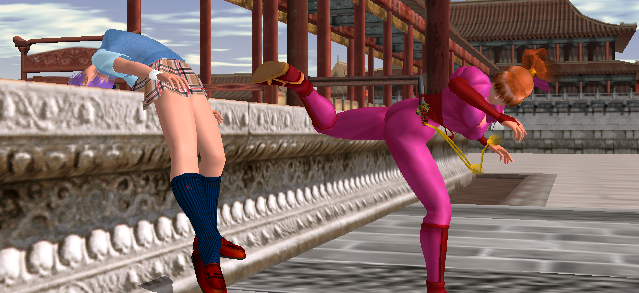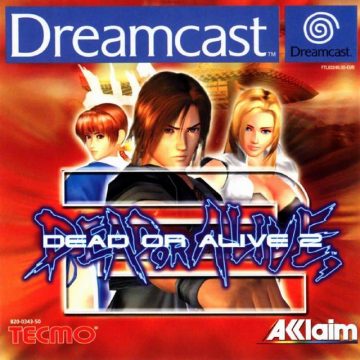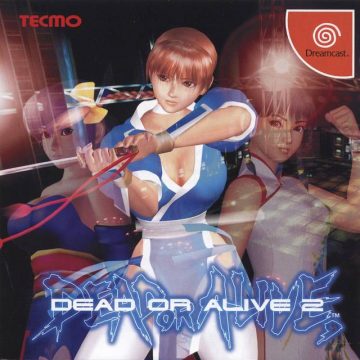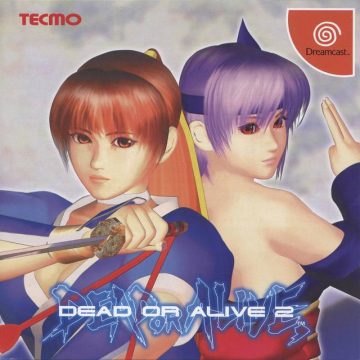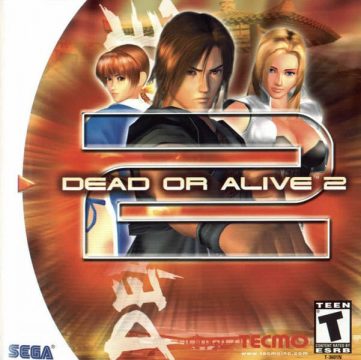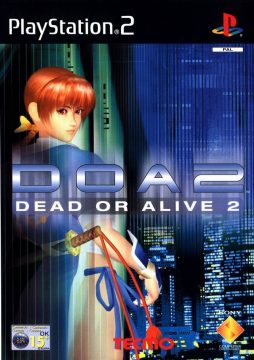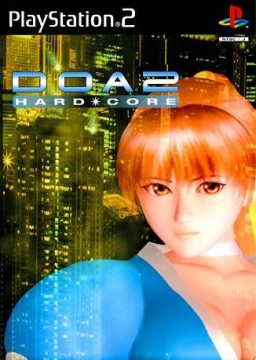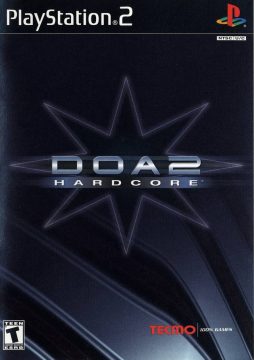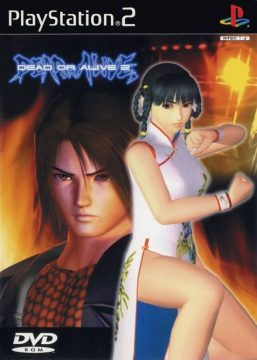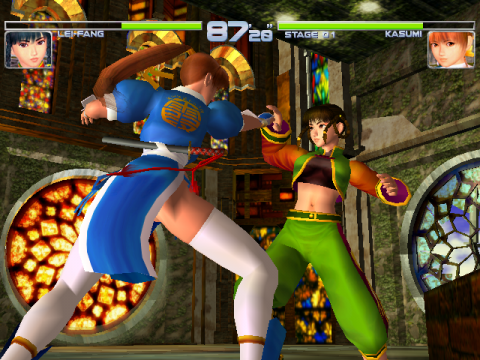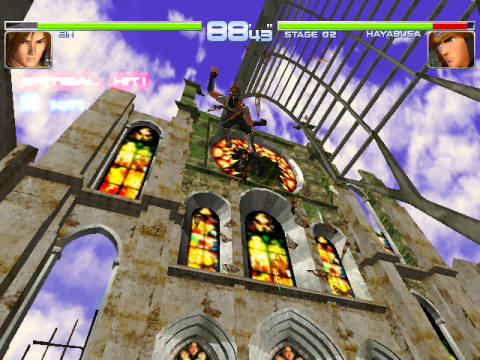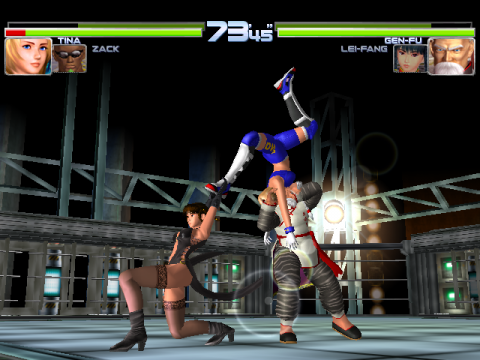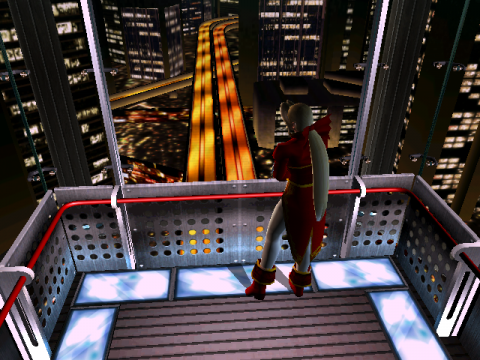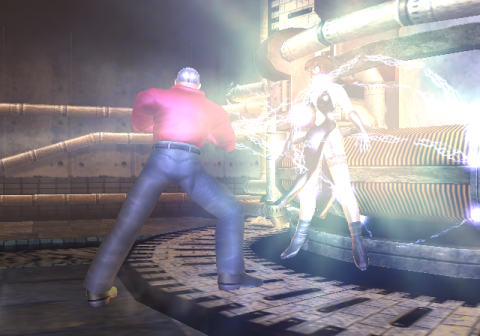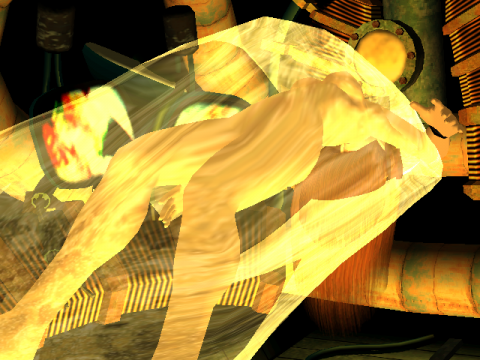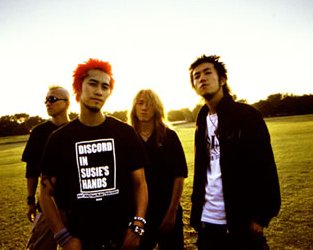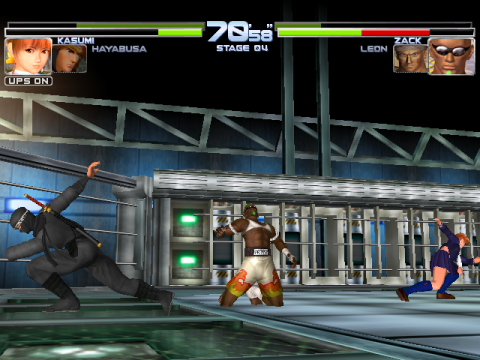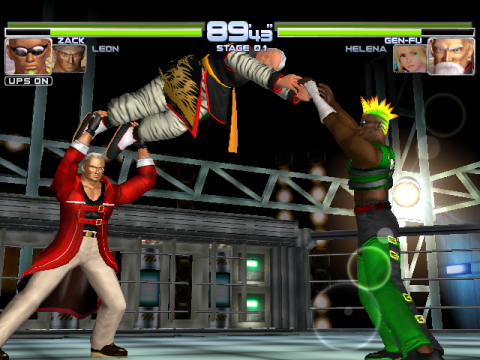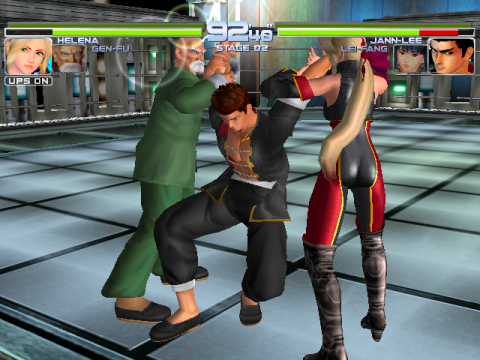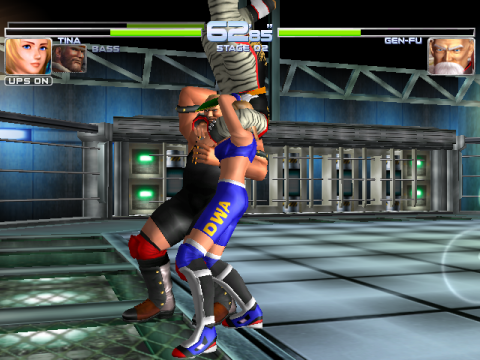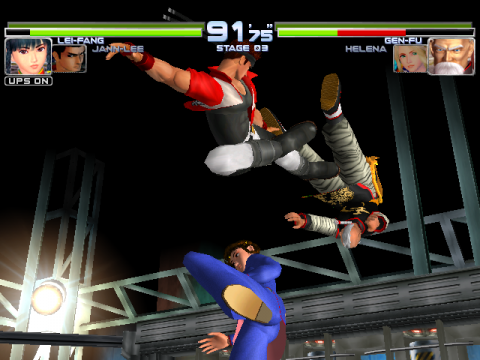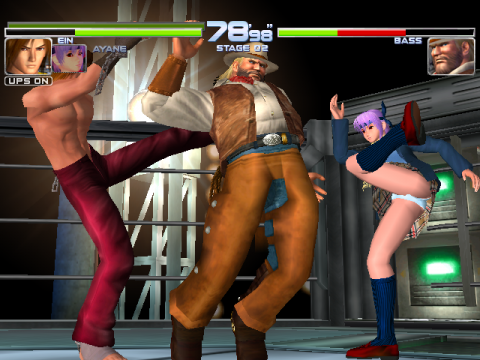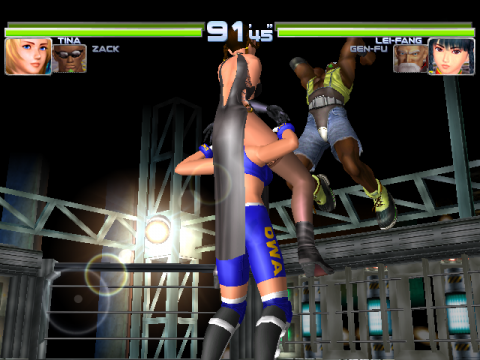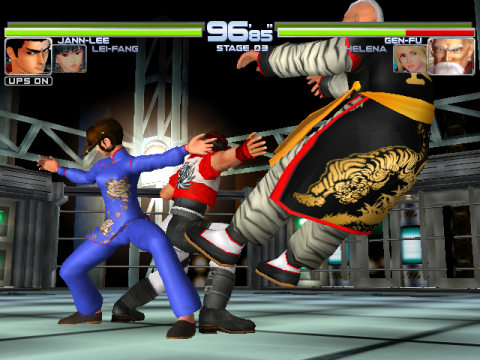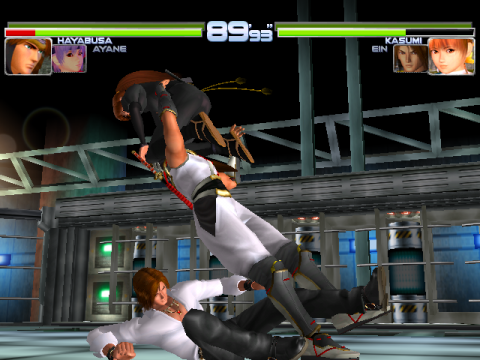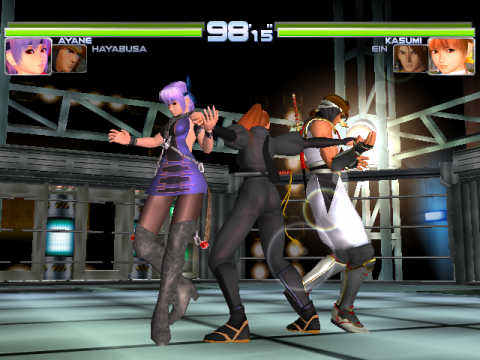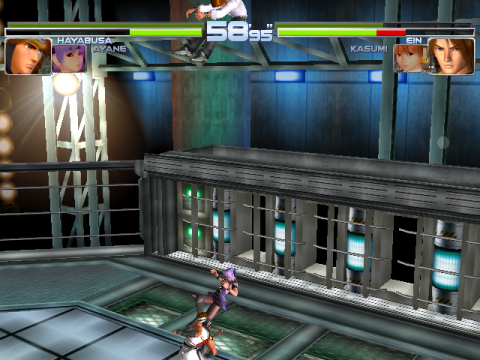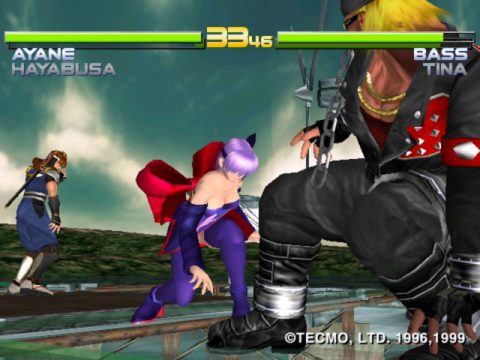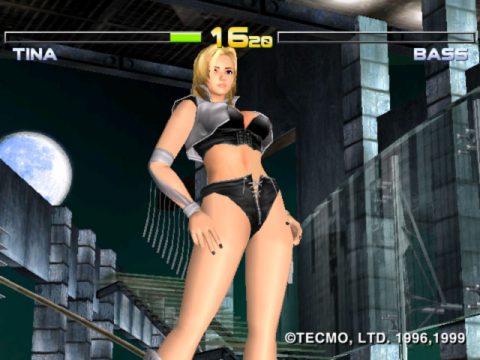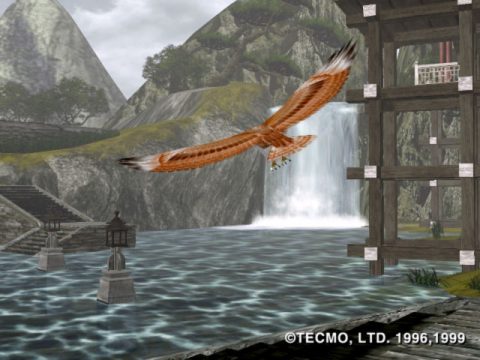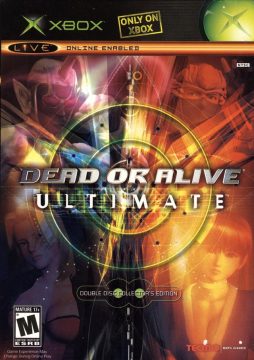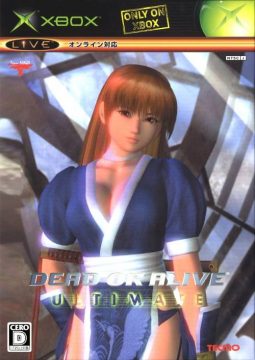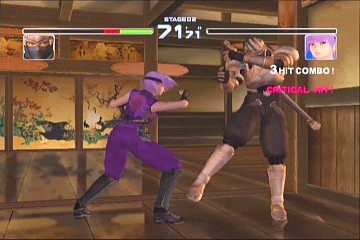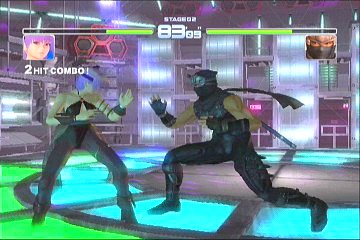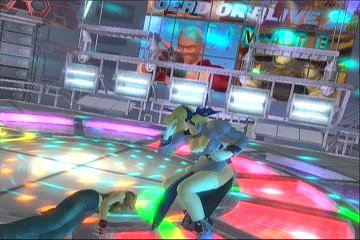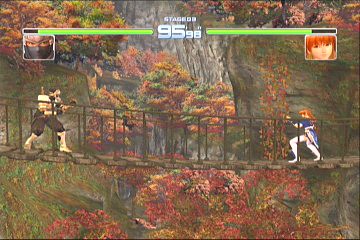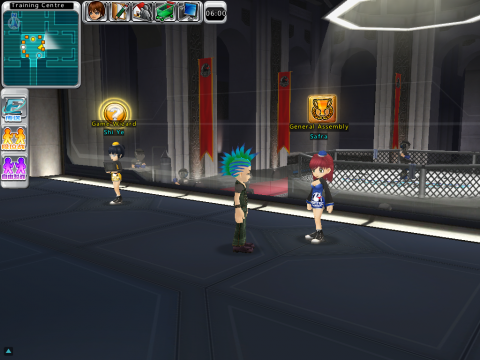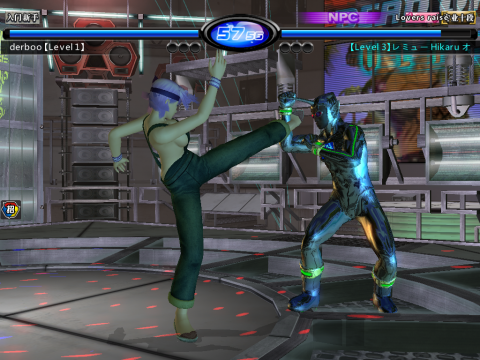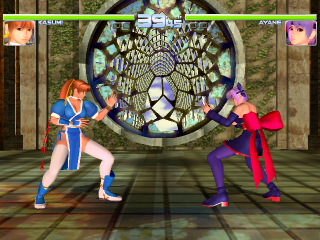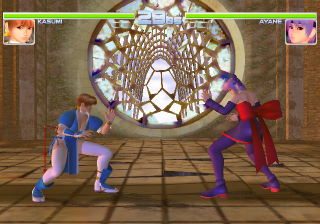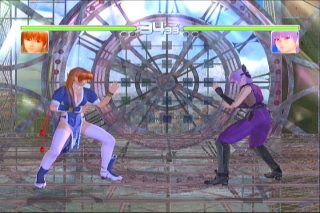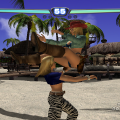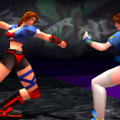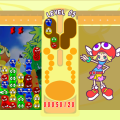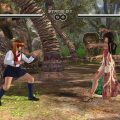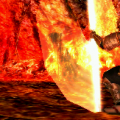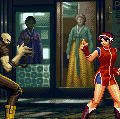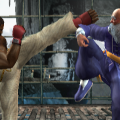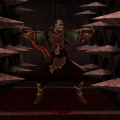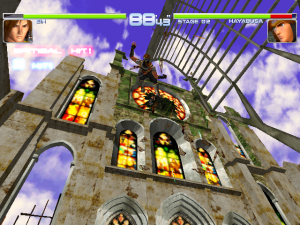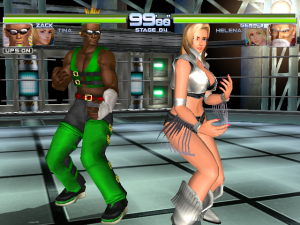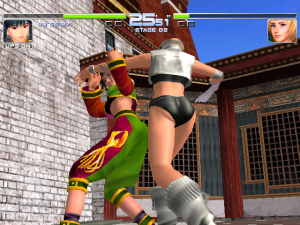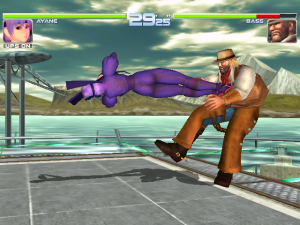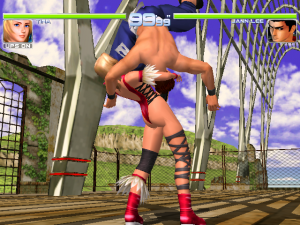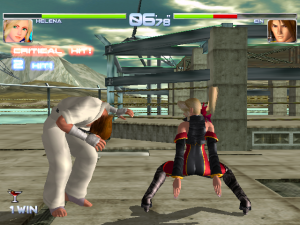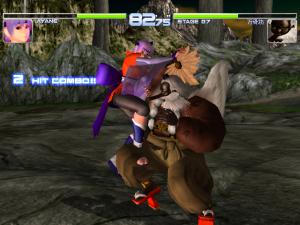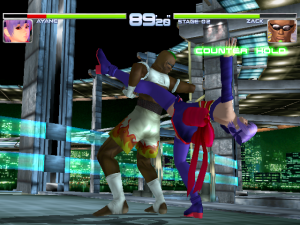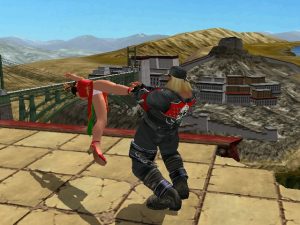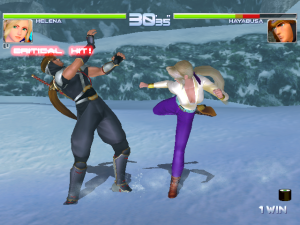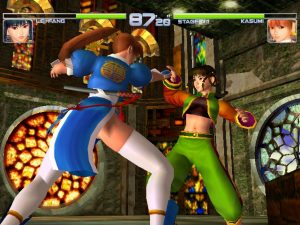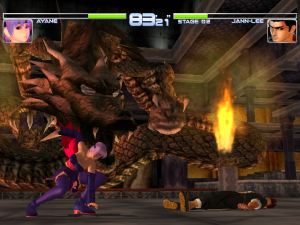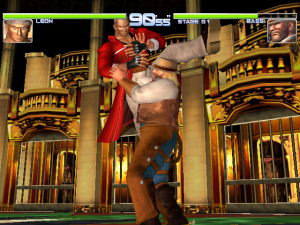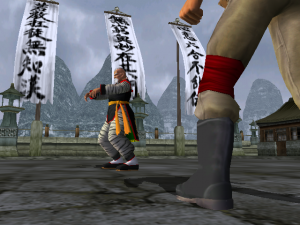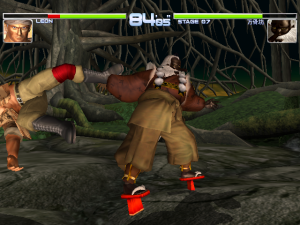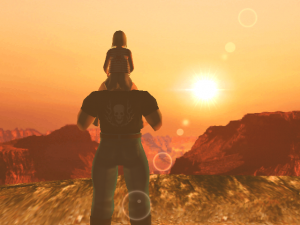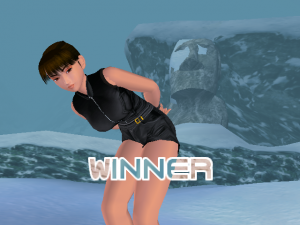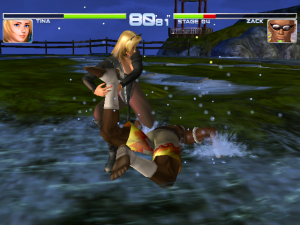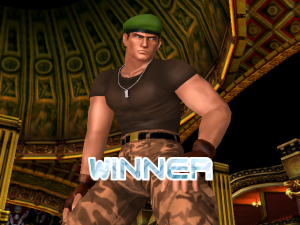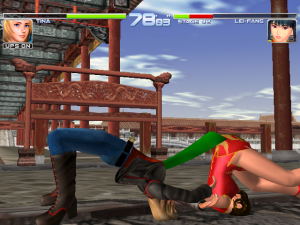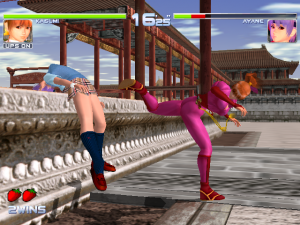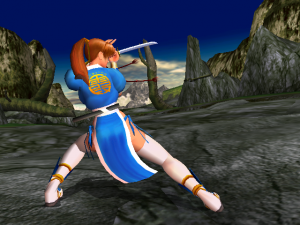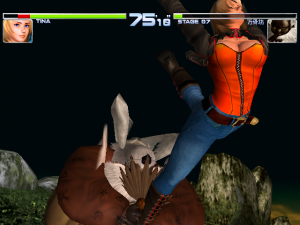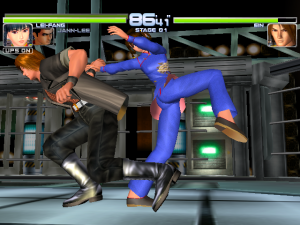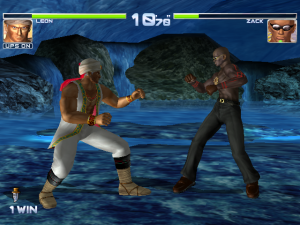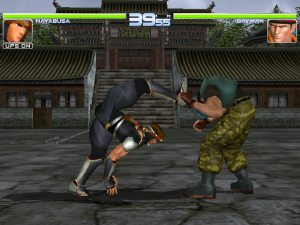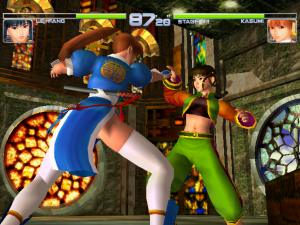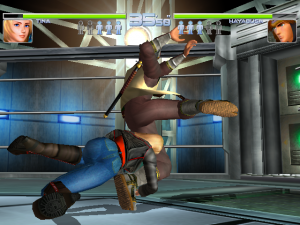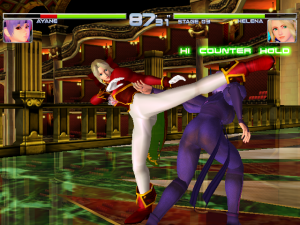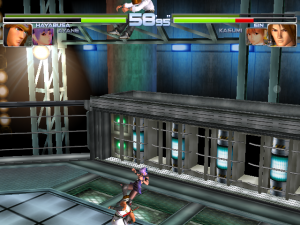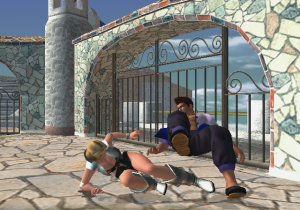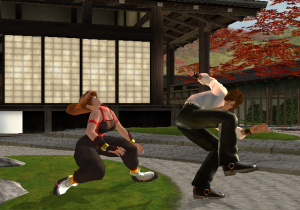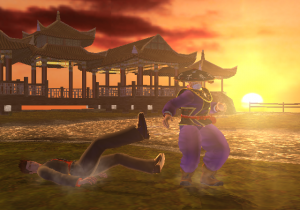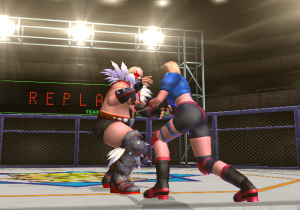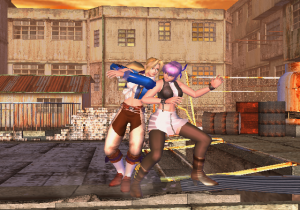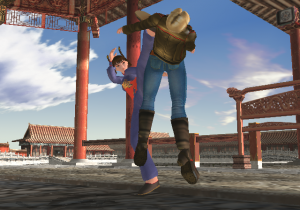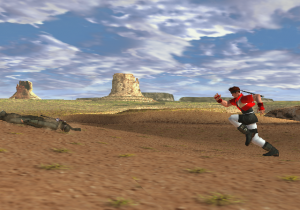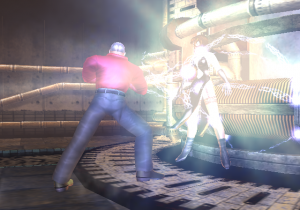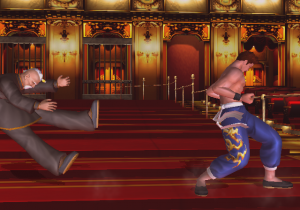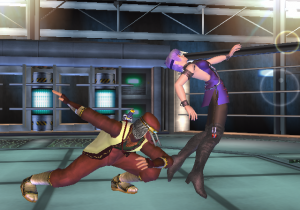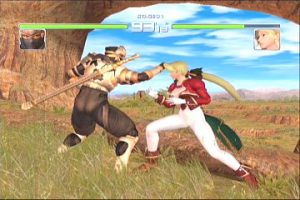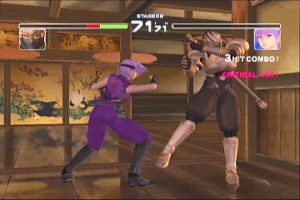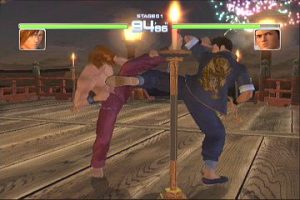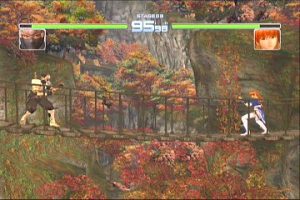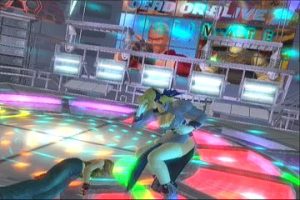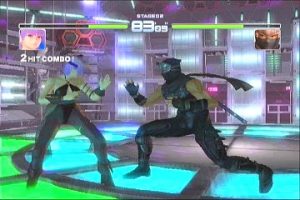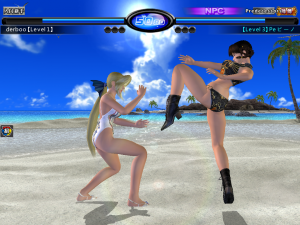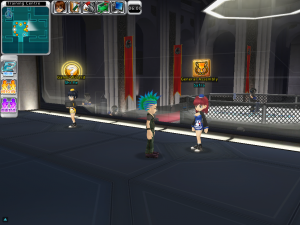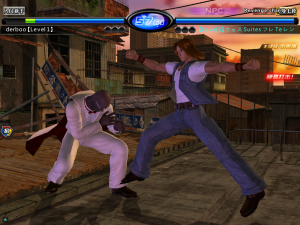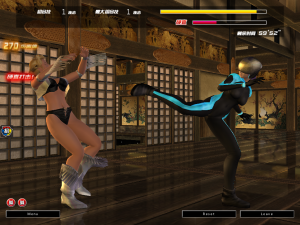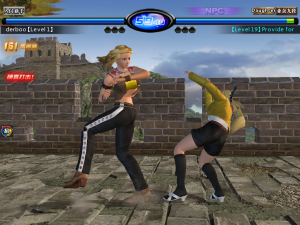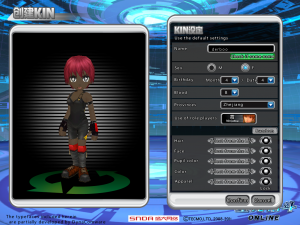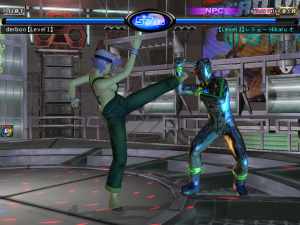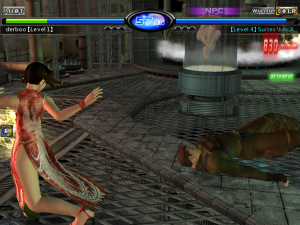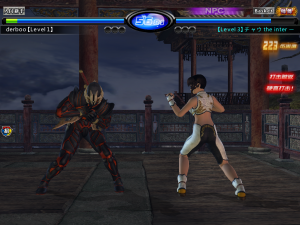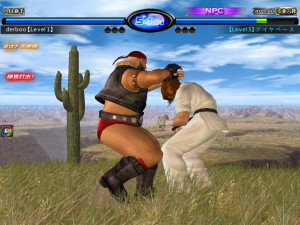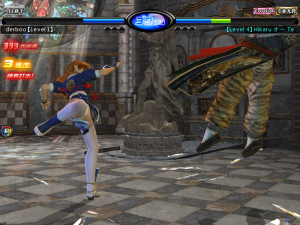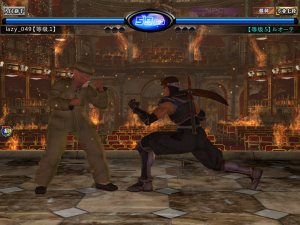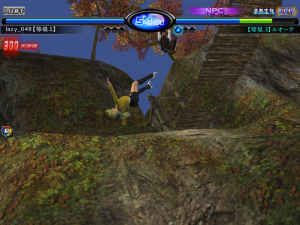As cool as the original Dead or Alive was, it was still little more than just a retolling of the standard 3D fighter template created by Sega. Powered by the new Naomi hardware, Dead or Alive 2 really pushed the boundaries towards what these games would eventually become. The character models have obviously been redone from scratch to look massively better, not only technically but on an artistic level as well. All of the graphics look amazingly better than the CG intro from the original Dead or Alive – better than the CG intros in pretty much any 32-bit generation game, for that matter. But the visuals weren’t even the real star.
The big new thing about Dead or Alive 2 were the multi-tiered fighting arenas. Virtua Fighter had experimented with natural, uneven stages with its third major iteration, but quickly abandoned the idea afterwards. Dead or Alive decided to pursue exactly that approach further and greatly expand on it. Samurai Shodown 64 was technically the first game to implement fighting over multiple storied levels after getting knocked down from a platform in Virtua Fighter 3 still always meant a ring out. But Dead or Alive 2 really popularized it and made it feel especially rewarding. These weren’t enclosed cages or plateaus or even rings – you fight on a skyscraper, in the Japanese wilderness, in the bell tower of a chapel. They’re littered with columns, changes in elevation, all of kinds of features that made the game feel so much more alive. And the intensity of the action triples when you first knock an opponent off of a cliff or out of a window, then leap down after them and begin fighting on a ledge below. The rather bizarre structure of the single player mode means that you’ll rarely get to see these arenas in full, though – each match lasts only one round, and they’re usually over in a matter of seconds.
Practically all of the cast from the original returns (except Bayman, at least for the initial versions), with a few additions: Helena, the opera singer; Ein, the karate pretty boy; and Tengu, the monstrous main boss. The tag mode introduced in Dead or Alive++ got a major overhaul, now allowing instant swaps and powerful team attacks – by pressing all three buttons at once switches the character, and doing so while pressing forward includes a mighty ass-whooping in the process, where both team mates rain down punishment on the opponent together or whirl them around the entire arena. This mode would become very popular amongst fans of the series. So popular in fact that Team Ninja was considering to make it the main play mode for further sequels.
The gameplay evolution picks up where Dead or Alive++ left, and this is where DOA really began to hit its stride as a series deserving of respect. One big new element is the introduction of full 3D movement. Using the Dreamcast’s directional pad lets you use regular 2D controls, while the analog stick is used to circle the opponent, which adds greatly to the strategy. Dead or Alive 2 also finally refined the counters to the form that the series is known for until today, with its pivotal role in the fighting dynamics. Pressing backwards and the block button just in time for the opponents’ attacks now results in a throw that uses their momentum to do the most damage of a single move in the game, but you have to properly guess whether the attack to counter is going to hit high, low or center. It’s even possible to trigger holds from light stuns to intercept the other player’s combo, but in that case they do significantly less damage. If you guessed wrong and your hold fails, on the other hand, you’re stuck in its animation until it ends and open for increased damage from the opponent’s attacks. Unless you’ve got razor sharp reflexes, it’s almost impossible to use holds as a reaction to faster attacks, so on low and mid level play, much of it is psychological play of guessing when and how the other player will attack.
he release history of Dead or Alive 2 borders on utter ridiculousness. The original release came out in October 1999 in Japanese arcades, then it was ported in April of 2000 for the Dreamcast in America. While it was a superb game, it still lacked much in the way of endings or the extra costumes that made the original so enjoyable. It hit the PlayStation 2 in Japan later in the summer – and while it added some more backgrounds and costumes, the designers clearly weren’t very comfortable with the new hardware. The graphics are extremely jaggy, and while the cutscenes run smoother, everything as a whole just looks much worse.
The next Version was the European release for Dreamcast, which added some interesting costumes, like a Shadowman outfit for Zack (it was published by Acclaim, who also made the Shadowman game), but had still less content than the PlayStation 2 version. Not long after this, the game was finally released in Japan on the Dreamcast, with all the costumes that were added to the PlayStation 2 version. It also features two new backgrounds that for some reason are different from the PS2 ones, but without the graphical detriments. The biggest improvement this time was the inclusion of two unlockable characters (Bayman from the first game, and the boss character Tengu). There was also a “Limited Edition” released simultaneously, but the only difference was in the cover art. This version was the only console upgrade (and the last DOA game over all) that made its way back into the arcades as Dead or Alive 2 Millenium.
In October of 2000, Dead or Alive 2: Hardcore was released in America. A few minor modes were added, including a battle recording mode and the so-called UPS system, a fancy name for profiles to save individual player stats. Mostly though, it fixes some of the graphical problems of the original PlayStation 2 release, although some jaggies are still noticeable in high motion. It also includes even more costumes, more story scenes, more backgrounds, and some utterly hilarious English voice acting.
Finally, in December 2000, Dead or Alive 2 Hardcore made it back to Japan, with yet more extra costumes, story scenes and gallery pictures. This version formed the basis for the European PlayStation 2 release, which was just labeled Dead or Alive 2, without the “Hardcore” suffix. And it’s still not over. In 2004 – five years after the original release – Tecmo released Dead or Alive Ultimate – which is the definitive version of Dead or Alive 2, with better graphics (running on the technology from Xtreme Beach Volleyball), even more costumes and backgrounds and, most importantly, online play. More info on that is found below.
The Dreamcast version of the game had a scene in the intro hidden from view – if you put in a code, you could unlock a part of a naked Kasumi clone in some kind of machine. Naturally, most of it was hidden to prevent an adult content rating, but with a Game Shark, you can use this model in the actual game. This kinda screws up the game, but it’s funny to see that they actually modeled nipples on her.
The opening song Exciter is rather well known for its incredibly incomprehensible English. Anime Lyrics has done a fine job of attempting to transliterate them, which given the mumbling, is easier said than done. Here’s some lines:
I just wanna be Exciter
A herd of Domestic dog, Cheap trick
Hide your drastic desire
I still stay there with a finger in my mouth
Classic. The folks who brought you this is a Japanese group known as Bomb Factory.
Tag Moves
Preview Images
Dead or Alive Ultimate – Xbox (2004)
Released for the original Xbox, Dead or Alive Ultimate contains the first and second games of the series, shipped in a cardboard foldout box that contains the two DVD cases (at least in the US, the European version is just one standard Amaray case for 2 discs). The first Dead or Alive is a straight port of the Saturn version, with higher res graphics. The second is a vastly improved version of Dead or Alive 2, using the DOA Xtreme Beach Beach Volleyball graphics engine.
There’s no doubt, it’s extraordinarily gorgeous – the characters all look better, and the backgrounds have been completely recreated, most of them expanded upon greatly. Among the cooler additions? Vats of Kasumi clones in the laboratory stage, wildlife inhabits the desert stage (including elephants, which you can knock your opponent into), and the opera stage slowly crumbles as the blazing fire tears it apart. The last boss has a particularly cool attack where he changes the seasons of the level, from a snow filled landscape to a sunny, grass filled mountain.
There’s a new three minute CG rendered movie telling the story of Kasumi, Ayane and Hayate when they were kids (like in Dead or Alive 3 set to an Aerosmith song – unfortunately, “Exciter” is noticeably absent. The terrible English voiceovers from the PlayStation 2 version are also gone.) Gameplay-wise, though, it’s pretty much just Dead or Alive 2 – Hitomi is now a playable character (although not in story mode) and there are a couple of new moves that allow you to slam your opponent into the ceiling or ride them down slopes, but all in all, nothing major has changed – with one exception.
Probably answering the criticisms about overpowered counters, Team Ninja came up with a change to make them more difficult to execute. Too bad what they did doesn’t make any intuitive sense. For countering a mid height kick now, you have to press forward and block, instead of back. The low and high kicks, though, as well as all the punches, still have to be countered the old way. This inconsistency really takes away from the natural, intuitive execution in former games, and just doesn’t feel quite right. Why couldn’t they implement a more consistent rule, like “kicks forward, punches backward”?
Despite the close rendition of DOA2‘s gameplay, there is a ton of new unlockables – Dead or Alive 2 Ultimatecontains well over a hundred costumes, including twenty for popular characters like Kasumi and Lei Fang. They’re also much easier to obtain than in DOA2: Hardcore. Once you’ve unlocked everything, you can also use the North American version to get the bonus costumes in Dead or Alive 3 and view the G4TV icons episode.
The biggest draw, though, is the online play. There’s a huge variance in lag – some matches, even highly rated ones, will run terribly, while others run almost as silk smooth as the offline game. The only bizarre part is the way the matches are set up – most of the time, you can’t fight against a single individual. Instead, you join a room of between three and eight players. Whoever wins, keeps playing, while the loser steps down the next challenger. It fosters an arcade like atmosphere, but often you spend more time watching than playing. Also, this “whoever wins, stays” method pretty much guarantees you’re going to be fighting against a really good player, which is especially frustrating if you don’t sit at home and practice Dead or Alive all day. If you can find people you know to play against online, the experience will be much better, but trying to quick search will probably result in frustration.
Notice: Since Microsoft shut down the original Xbox servers, the online features cannot be used anymore.
Dead or Alive Online / Shendsi Gedou (生死格斗) – Windows (2008)
There was yet another iteration of Dead or Alive Ultimate, a Chinese version called Dead or Alive Online, developed by Shanda for the PC. As the title suggests, the game was online only and came with an extended lobby/MMO part where people could run around as player-created SD characters and challenge each other to fights.
The title was never formally released, but it ran in open beta from December 2008 to January 2011, when Tecmo announced the shutdown of the servers. Fans have patched the client to work with customs servers, though, so it can still be played. But at the end of the day, it’s just Dead or Alive 2 Ultimate minus the offline modes. Even worse, like any online game it has a leveling system, but here it seems the level affects the actual damage during combat – the absolute death stroke for a formerly skill-based fighting game.
Comparison Screenshots
